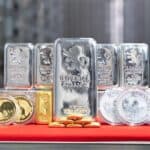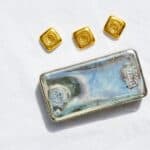The prices of gold and silver are watched closely by Australians who buy and sell bullion. Unlike fixed retail items, precious metal prices change every few minutes. Understanding why these shifts occur helps you make sense of the numbers you see when checking the gold or silver price in Australia today.
This article explains the key factors that influence gold and silver prices in Australia. From global spot prices and currency exchange rates to supply, demand and local mining activity, these elements combine to set the rates you see at bullion dealers like Imperial Bullion.
The Global Spot Price
At the core of all bullion pricing is the global spot price. This is the benchmark rate at which gold and silver are traded internationally for immediate delivery.
Gold spot price in Australia
When you look at the gold price today in AUD, it is based on the international spot price, converted from US dollars into Australian dollars.
Silver spot price in Australia
The same applies to silver. The silver price per ounce in Australia follows the global spot price, adjusted for local currency.
The spot price is determined by major international markets, such as the London Bullion Market Association (LBMA) and the COMEX exchange in New York. Local dealers then use this spot price to calculate their own buy and sell rates, adding a small margin for costs and operations.
Currency Exchange Rates (AUD vs USD)
One of the most important influences on bullion prices in Australia is the strength of the Australian dollar against the US dollar.
Gold and silver are priced in US dollars on global markets. This means that when the Australian dollar weakens, the gold price in AUD and the silver price in AUD will rise, even if the international spot price remains steady. Conversely, a stronger Australian dollar can make local bullion prices appear lower.
For example: If the US dollar price of gold is unchanged but the Australian dollar falls against the US dollar, you will see a higher gold price per ounce in Australia.
The same applies to silver, making the silver price per gram in Australia directly affected by currency movements.
This is why many Australians notice differences between international news reports on bullion and the actual rates shown by local dealers.
Supply and Demand Dynamics
Like all commodities, gold and silver prices are influenced by supply and demand.
Gold Supply and Demand
Gold supply mainly comes from mining and recycling. While gold mining is steady, it is not easy to ramp up quickly, meaning supply is relatively fixed. Demand can fluctuate depending on jewellery demand, central bank purchases and bullion sales.
Silver Supply and Demand
Silver has a different profile. Alongside its role in coins and bars, silver is heavily used in industry. Electronics, medical devices, batteries and especially solar panels consume large amounts of silver each year. This industrial demand can cause the silver market in Australia to be more volatile than gold.
When demand rises sharply, prices climb. When demand slows or supply increases, prices can ease. This is a natural part of the market cycle for both metals.
Economic Conditions
Broader economic factors also affect bullion prices.
Inflation
Rising inflation often increases interest in gold and silver as stores of value.
Interest rates
Higher interest rates can make non-yielding assets like bullion less attractive, while lower rates can have the opposite effect.
Global economy
Periods of economic stability can ease demand, while uncertainty or downturns often increase buying interest.
It is important to note that this is context, not advice. These are simply some of the economic factors that influence gold and silver prices worldwide and, by extension, in Australia.
Mining and Refining in Australia
Australia is one of the world’s largest producers of both gold and silver.
Australian gold mining contributes a significant share of global output. Major goldfields in Western Australia and other states supply both local and international markets.
Australian silver production comes from dedicated silver mines as well as a by-product of lead, zinc and copper mining.
While the global spot price has the biggest impact on local pricing, changes in mining output and refining capacity can also influence the domestic bullion supply. This in turn, may affect dealer availability and premiums on certain products.
Market Sentiment and Geopolitics
Global events play a powerful role in shaping bullion prices.
- Political instability: Elections, conflicts or trade disputes can cause uncertainty, which often drives demand for gold and silver.
- Geopolitical tension: When global relations become strained, bullion can see increased demand as a safe haven asset.
- Market sentiment: Investor confidence, media reporting and general perception of risk also contribute to the day to day movement of prices.
For example, when global tensions rise, many people look at the gold price in Australia today as a gauge of broader market concern.
Top 5 Factors Influencing Gold & Silver Prices in Australia
| Factor | How It Affects Prices | Impact on Gold | Impact on Silver |
| Global Spot Price | International benchmark that sets the base price for all bullion | A rise in the global gold spot price immediately lifts the gold price per ounce in Australia | Silver prices follow global market movements, raising or lowering the silver price per gram in Australia. |
| AUD vs USD Exchange Rate | Gold and silver are priced in US dollars worldwide, so currency movements directly affect local pricing. | A weaker Australian dollar means higher local gold prices even if the global spot price is stable. | The same applies to silver, making the silver price in AUD more expensive when the Australian dollar drops. |
| Supply and Demand | Mining output, recycling levels and industrial usage shape market supply and demand. | Steady gold mining supply vs central bank demand can tighten or ease the market. | High industrial demand (electronics, solar panels) can cause silver prices to rise sharply. |
| Economic Conditions | Inflation, interest rates and global economic trends change how people buy and sell precious metals. | Rising inflation or lower interest rates often increase demand for gold as a store of value. | Industrial slowdowns or growth spurts directly influence silver market demand and pricing. |
| Market Sentiment & Geopolitics | Global events, political tensions and investor confidence influence short-term market moves | Geopolitical uncertainty (such as trade disputes) can push gold prices higher as a safe-haven asset. | Silver reacts to both safe-haven demand and industrial trends, making its moves sometimes sharper. |
Why Prices Differ Between Dealers
You may notice that the buy and sell prices listed by different bullion dealers vary slightly. This is not because the spot price changes between dealers, but because of premiums and spreads.
- Premiums: These cover costs of minting, refining, shipping and dealer overheads. Coins often carry higher premiums than bars due to their design and collectability.
- Spreads: The difference between the buy price and the sell price is known as the spread. This allows dealers to operate sustainably.
At Imperial Bullion, we pride ourselves on publishing live, transparent prices so customers can clearly see both buy and sell rates
You can view our live sell prices or explore our buy range anytime.
How Imperial Bullion Provides Clarity
When navigating changing bullion prices, choosing a trusted bullion dealer in Australia is essential. At Imperial Bullion we provide:
- Live gold and silver prices updated every few minutes in AUD
- Transparent buy and sell spreads clearly displayed online
- Accredited bullion products from trusted mints and refiners
- Competitive rates for both buying and selling
- Secure transactions in-store and online
Frequently Asked Questions
The gold price in Australia is determined by the international gold spot price, converted into Australian dollars, and influenced by factors such as supply, demand, currency exchange rates and dealer premiums.
The silver price changes because it is traded on global markets. Shifts in supply, industrial demand, currency movements and market sentiment all contribute to daily changes.
Because gold and silver are priced in US dollars globally, a weaker Australian dollar makes bullion more expensive locally, while a stronger dollar makes it cheaper.
Gold and silver often move in the same direction, but not always. Silver is more heavily influenced by industrial demand, which can make it more volatile.
The difference reflects premiums and spreads, which cover refining, handling and dealer operations. Accredited dealers like Imperial Bullion provide transparent rates so customers know exactly what they are paying or receiving.
Final Thoughts
The factors that influence gold and silver prices in Australia are complex but can be grouped into clear categories: international spot prices, currency exchange rates, supply and demand, economic conditions, mining output, and global events.
By understanding these elements, you can better interpret why the gold price in AUD or the silver price in AUD changes from day to day. While prices will always fluctuate, transparency from accredited dealers ensures you have the information you need to make informed decisions.
At Imperial Bullion we provide live updates, secure transactions and genuine bullion products backed by trust and accreditation.
Explore our gold and silver bullion range today and see the latest gold and silver prices in Australia with confidence.




